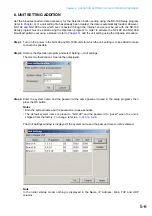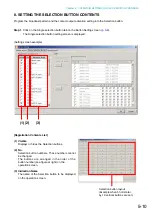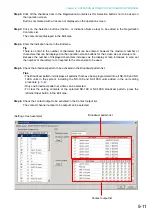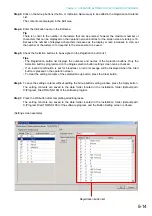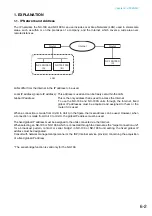
6-4
Chapter 6: APPENDIX
1.4. Multicast and Simultaneous Multiple Broadcasts
The multicast communication method can be utilized to make simultaneous broadcasts to two or more units.
The advantage of multicast operation is the possibility of decreasing traffic. Networks that use multicast
communication need to be supported by multicast addresses and Internet Group Management Protocol
(IGMP). The effective multicast address range is from 225.0.0.0 to 238.255.255.255.
Note
Follow the instructions of the network management personnel for the effective range of the broadcast.
1.5. Packet Loss Recovery
The NX-100 and NX-100S convert audio data into IP packets to carry out communications. According to the
condition of the network to be used, packets may be lost, deteriorating sound quality. The NX-100 and NX-
100S offer the following 3 different selection modes for recovering such lost packets.
Standard:
Corrects for lost packets with a silent gap. This method helps reduce delay times and
bandwidth, and is appropriate for applications that emphasize real-time operability. However,
it is not well-suited to networks in which many packet losses may occur, because the good
sound quality cannot be maintained.
Error Correction: Recovers lost packets with redundant data. Since only short-time losses can be corrected,
this method is not appropriate for networks in which many packet losses may occur. It is,
however, appropriate for applications that require high sound quality, such as LAN, which
have lower chances of packet loss.
Resend:
Corrects by automatically resending lost packets. All packet losses that occur within the
preset delay time can be corrected. High sound quality can be maintained even on such
networks as the Internet, which may generate many packet losses. This method, however, is
not well-suited to applications that emphasize real-time operability, because of longer delay
times.
Standard
Note:
Numbers represent level of advantage in the order of 1, 2, 3.
Error correction
Resend
Packet loss recovery ability Real-time operability
Band occupation
3
1
Small
2
2
Moderate
1
3
Large
1.6. Contact OFF Delay Time
Depending on the packet loss recovery setting, delay times may be generated in broadcasts.
Long delay times do not take place in the contact bridge function. Therefore, if the contact is set so that it
becomes OFF when broadcasts are terminated, the contact may be turned OFF before broadcast completion.
To leave the contact ON until broadcast completion, the contact OFF delay time of the NX-100 or NX-100S
that provides contact output needs to be set to be longer than the broadcast delay time in the contact setting.
(The broadcast delay time is displayed on the Broadcast Spec setting screen.)
1.7. Sampling Frequency Correction
Synchronizes all NX-100 and NX-100S operation clocks in the system.
Unless the operation clocks are all synchronized, sound losses can occur in broadcasts that last more than 2
minutes. For example, to realize sampling frequency (fs) correction between units connected to Networks A
and B, perform fs correction data transmission setting for any one of the NX-100 and NX-100S units
connected to Network A. Set the target transmission unit of the correction data to the Network B router IP
address. Set the sampling frequency reception for any one of the NX-100 and NX-100S units connected to
Network B. Add the address translation of the unit set to receive the correction data to the Network B router.
Note, however, that this setting is not needed when limited to use within the LAN*, because the sampling
frequency is automatically corrected.
* Broadcast effective range
Summary of Contents for NX-100
Page 6: ...Chapter 1 BEFORE INSTALLATIONS AND SETTINGS ...
Page 12: ...Chapter 2 UNIT AND SOFTWARE INSTALLATIONS ...
Page 27: ...Chapter 3 SYSTEM SETTINGS NX 100 SETUP PROGRAM ...
Page 58: ...Chapter 4 SYSTEM SETTINGS SETTING USING BROWSER ...
Page 89: ...Chapter 5 OPERATION SETTINGS NX 100 OPERATION PROGRAM ...
Page 104: ...Chapter 6 APPENDIX ...
Page 114: ...200708 URL http www toa jp ...


